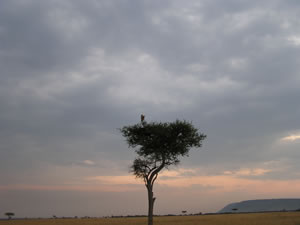Trees
and Rain
 Is
it correct to say, like those wazee at the turn of the century, that
trees bring rain? There is even an Ethiopian proverb that insists,
"Trees pull the rain", and we recognize the truth in it.
Most of us realize that there is a relationship between well-forested
land and total rainfall. The question remains; which came first, the
rain or the trees, because we are talking of the huge hydrological
cycle on our earth, and the way it manifests itself in different places.
Is
it correct to say, like those wazee at the turn of the century, that
trees bring rain? There is even an Ethiopian proverb that insists,
"Trees pull the rain", and we recognize the truth in it.
Most of us realize that there is a relationship between well-forested
land and total rainfall. The question remains; which came first, the
rain or the trees, because we are talking of the huge hydrological
cycle on our earth, and the way it manifests itself in different places.
Recent evidence from scientific
studies in the Amazon rainforest indicates that trees do have an influence
on total rainfall. According to this study, 75% of all rainfall recirculates
into the atmosphere via evaporation and transpiration over heavily
forested areas. Only 25% runs off over the land to streams and rivers.
In areas extensively cleared for cultivation or pasture, the situation
reverses, as 75% runs off and only 25% is recirculated. (3) This reduces
atmospheric moisture and thereby reduces rainfall downwind of the
cleared zone.
But Kenya
is not the Amazon. Our forests are not extensive, and the impact of
recirculated moisture is much smaller. Perhaps there is some effect,
but this is probably too small to measure. Kenya's rainfall pattern
is governed primarily by the movement of the monsoon in combination
with the highlands and mountains. Mt. Kenya, the Aberdare Range, the
Cherangani Hills, Mau Escarpment, Mt. Elgon, and even the lower ranges
like Mt. Marsabit, Mt. Kulal, and the Chyulu Hills affect their surrounding
climate by slowing down air movement, forcing it higher, which causes
condensation into clouds and then rainfall. This will happen whether
the forest is there or not.
Yet there are important, water-related
reasons for preserving our forests and creating new ones, the first
concerns these very clouds that the mountains help create. These wrap
the mountain in a cloak of moisture-laden air. It may not rain, yet
the trees seem to drip as if it were. What happens is this: water
droplets from the clouds drift by the trees. When a droplet touches
a leaf, it sticks. Other droplets join it, eventually creating a large
drop. This drop is forced by gravity to fall from the leaf to the
ground. The number of drops reaching the ground depends on the surface
area of leaves available for droplets to touch. A forest provides
far more surface area than grass or bare ground. This kind of precipitation
is called ‘occult’ precipitation and can amount to over
500mm annually if conditions are right. Some people in the Huri Hills,
west of Marsabit, have succeeded in simulating this method of occult
precipitation by erecting large plastic sheets to catch the fog-laden
moisture. It can be a significant source of water for many uses.
Many hilly areas in Kenya are
prime areas for catching occult precipitation if trees are re-established.
Even now, some of the higher mountains in Turkana District are covered
with this mist forest, dominated by species like Juniperus procera
and Podocarpus gracilior. In Machakos, many hills of similar elevation
have been cleared for agriculture. What effect this has had on streams
in the area is not documented, but older people talk convincingly
of times when water-courses flowed year round. The absence of occult
precipitation certainly has an impact on this. Reforesting hill tops
may not miraculously bring back year round streams, but it will positively
influence the local environment in other ways.
NOTES:
3. Bayard Webster, IDRC Reports No. 4, Volume 12, International Development
Research Centre, Ottawa.
 Is
it correct to say, like those wazee at the turn of the century, that
trees bring rain? There is even an Ethiopian proverb that insists,
"Trees pull the rain", and we recognize the truth in it.
Most of us realize that there is a relationship between well-forested
land and total rainfall. The question remains; which came first, the
rain or the trees, because we are talking of the huge hydrological
cycle on our earth, and the way it manifests itself in different places.
Is
it correct to say, like those wazee at the turn of the century, that
trees bring rain? There is even an Ethiopian proverb that insists,
"Trees pull the rain", and we recognize the truth in it.
Most of us realize that there is a relationship between well-forested
land and total rainfall. The question remains; which came first, the
rain or the trees, because we are talking of the huge hydrological
cycle on our earth, and the way it manifests itself in different places.